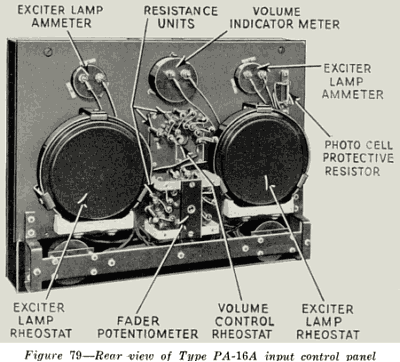To increase the current (i.e., cut out resistance) on rheostats mounted on input control panels,
turn the knob to the left, or counter-clockwise, and turn the knob to the right, or clockwise, to
do the same thing on rheostats mounted on projectors. The direction is indicated on the
rheostat mounting. Most of the rheostats on input control panels, and all of those mounted on
projectors, have a "dead point," or can be turned to an open circuit position. This makes the
rheostat serve the purpose of a switch as well.
The exciter lamps should be run at nearly their maximum rating. As has been pointed out in
section 84, there are two types in use, the 5 ampere and the 7 ½
ampere. Although the exciter
lamp current can be varied at will, the lamps should not be used as volume controls. The
current values should be equalized, and the only exception to this is the necessary balancing of
sound-on-film output
 in order to compensate for photo-electric cells of slightly different sensitivities. As it is
impossible always to secure cells of exactly the same values, it is then very easy to decrease
the exciter lamp current of the projector containing the more sensitive cell until the sound
output is equal to that from the other projector. The adjustment necessary will be very slight.
The current values which give equal output should then be remembered, and the same setting
used every day. Both exciter lamps should always be turned on, except when running on disc.
in order to compensate for photo-electric cells of slightly different sensitivities. As it is
impossible always to secure cells of exactly the same values, it is then very easy to decrease
the exciter lamp current of the projector containing the more sensitive cell until the sound
output is equal to that from the other projector. The adjustment necessary will be very slight.
The current values which give equal output should then be remembered, and the same setting
used every day. Both exciter lamps should always be turned on, except when running on disc.
114. Purpose of the Fader.-In order to change the sound output of the projectors from one to
the other as each succeeding reel of film comes to an end, a change-over switching
arrangement, known as a fader, is used. This change, in different types of Photophone
equipment, is accomplished in two different ways. Types PG-1, 2, 10 and 13 use a relay
actuated by either of two switches, one
for each projector. Types PG-3, 4, 6, 7 and 8 make use of a special type of potentiometer.
5
